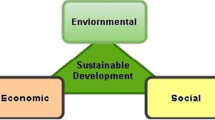Abstract
The purpose of this study was the identification of the major factor for sustainable development in textile industries and preferred textile wastewater management practices for environmental protection. Moreover, a structural framework for sustainable textile wastewater management concept in the textile industry was developed, and further, the proposed model was examined based on the effect of economic performance, environmental impact, and operational performance in textile sectors. Therefore, to achieve the above issues, major factors were identified through exhaustive literature, and then a test was conducted for the reliability of the proposed constructs for validation. However, there was no specific study on the sustainability of textile wastewater management principle by using exploratory structural equation modeling (SEM). Finally, the proposed structural model was validated by confirmatory factor analysis (CFA) and structural equation modeling with the help of the SPSS software package.




Similar content being viewed by others
References
Ajayi, S. O., & Oyedele, L. O. (2018). Critical design factors for minimising waste in construction projects: a structural equation modelling approach. Resources, Conservation and Recycling, 137, 302–313.
Anderson, J. C., & Gerbing, D. W. (1988). Structural equation modeling in practice: a review and recommended two-step approach. Psychological Bulletin, 103, 411–423.
Bagozzi, R., & Yi, Y. (1988). On the evaluation of structure equation models. Journal of the Academy of Marketing Science, 16, 74–94.
Cambero, C., & Sowlati, T. (2014). Assessment and optimization of forest biomass supply chains from economic, social and environmental perspectives—a review of literature. Renewable & Sustainable Energy Reviews, 36, 62–73.
Chatzisymeon, E., Xekoukoulotakis, N. P., Coz, A., Kalogerakis, N., & Mantzavinos, D. (2006). Electrochemical treatment of textile dyes and dyehouse effluents. Journal of Hazardous Materials, 137, 998–1007.
Chavan, R. B. (2001). Indian textile industry-environmental issues. Indian Journal of Fiber & Textile Research, 26, 11–21.
Comrey, A. L., & Lee, H. B. (1992). A first course in factor analysis. Hillsdale: Erlbaum.
Erdumlu, N., Ozipek, B., Yilmaz, G., & Topatan, Z. (2012). Reuse of effluent water obtained in different textile finishing processes. AUTEX Research Journal, 12, 23–28.
Gómez Fernández, J. F., & Crespo Márquez, A. (2012). Maintenance management in network utilities. Springer Series in Reliability Engineering. https://doi.org/10.1007/978-1-4471-2757-4.
Hair, J. F., Black, B., Babin, B., Anderson, R. E., & Burke, R. L. T. (2006). Multivariate data analysis (6th ed.). Upper saddle River: Pearson Prentice Hall.
Kaiser, H. F. (1974). An index of factorial simplicity. Psychometrika, 39, 31–36.
Kannan, V. R., & Tan, K. (2005). Just-in-time, total quality management, and supply chain management: understanding their linkages and impact on business performance. Omega, 33, 153–162.
Neto, S. A. S., Dantas, M. J. P., & Machado, R. L. (2017). Structural equation modeling applied to assess industrial engineering students’ satisfaction according to ENADE 2011. Production, 27, 2016–2191.
Njoh, A. J. (2017). The SWOT model’s utility in evaluating energy technology: illustrative application of a modified version to assess the sawdust cookstove’s sustainability in sub-Saharan Africa. Renewable and Sustainable Energy Reviews, 69, 313–323.
PashaeiKamali, F., Meuwissen, M. P. M., Boer, I. J. M., Middelaar, C. E., Moreira, A., & Lansink, A. G. J. M. O. (2017). Evaluation of the environmental, economic, and social performance of soybean farming systems in southern Brazil. Journal of Cleaner Production, 142, 385–394.
Pattnaik, P., Dangayach, G. S., & Bhardwaj, A. K. (2018). A review on the sustainability of textile industries wastewater with and without treatment methodologies. Reviews on Environmental Health, 33, 163–203.
Pett, M. A., Lackey, N. R., & Sullivan, J. J. (2003). Making sense of factor analysis: the use of factor analysis for instrument development in health care research. California: Sage Publications Inc.
Schumacker, R., & Lomax, R. A. (2004). Beginner’s guide to structural equation modeling (2nd ed.). Mahwah: Lawrence Erlbaum.
Taha, M., Adetutu, E. M., Shahsavari, E., Smith, A. T., & Ball, A. S. (2014). Azo and anthraquinone dye mixture decolourization at elevated temperature and concentration by a newly isolated thermophilic fungus, Thermomucorindicae-seudaticae. Journal of Environmental Chemical Engineering, 2, 415–423.
Taran, M., Sharifi, M., & Bagheri, S. (2011). Utilization of textile wastewater as carbon source by newly isolated Haloarcula sp. IRU1: optimization of conditions by Taguchi methodology. Clean Technologies and Environmental Policy, 13, 535–538.
Vineta, S., Silvana, Z., Sanja, R., & Golomeova, S. (2014). Methods for waste waters treatment in textile industry. International Scientific Conference 21–22 November, GABROVO.
Wijannarong, S., Aroonsrimorakot, S., Thavipoke, P., Kumsopa, C., & Sangjan, S. (2013). Removal of reactive dyes from textile dyeing industrial effluent by ozonation process. APCBEE Procedia, 5, 279–282.
Yuan, K. H., & Tian, Y. (2015). Structural equation modeling as a statistical method: an overview. JSM Mathematics and Statistics, 2, 1–6.
Živkovi’c, S. B., Veljkovi’c, M. V., Bankovi’c-Ili’c, I. B., & Krstić, I. (2017). Technological, technical, economic, environmental, social, human health risk, toxicological and policy considerations of biodiesel production and use. Renewable and Sustainable Energy Reviews, 79, 222–247.
Acknowledgments
The authors are grateful for all the HR managers and workers of textile industries for their active participation in the present survey to shape the initial draft for the sustainability of textile wastewater questioner, and their comments made for successful development of a valid structural model.
Author information
Authors and Affiliations
Corresponding author
Ethics declarations
Conflict of Interest
The authors declare that they have no conflict of interest.
Additional information
Publisher’s Note
Springer Nature remains neutral with regard to jurisdictional claims in published maps and institutional affiliations.
Appendix
Appendix
Rights and permissions
About this article
Cite this article
Pattnaik, P., Dangayach, G.S. Analysis of Influencing Factors on Sustainability of Textile Wastewater: a Structural Equation Approach. Water Air Soil Pollut 230, 156 (2019). https://doi.org/10.1007/s11270-019-4206-x
Received:
Accepted:
Published:
DOI: https://doi.org/10.1007/s11270-019-4206-x




